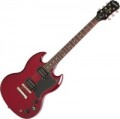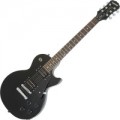Coil cutoff
The ability
to disable one of the coils in a humbucking pickup.
Pickups with this feature are, in fact, universal modules that can operate in both humbucking and single-coil modes. See "Pickup Diagram" for details on both. And the ability to switch between these modes allows the musician to change the colour of the sound without resorting to external gadgets or changing instruments. For example, for a dynamic composition with rich overdrive, it is more convenient to use a classic humbucker, and for a slow, lyrical melody, just move the switch and you can enjoy all the advantages of a single-coil.
Volume controls
The number of volume controls provided in an electric guitar.
If there is only one knob, this means that the musician can only adjust the overall volume of the instrument. However, there are models that have several volume control knobs — usually there are no less of them than pickups (2 or 3), which allows you to separately adjust the volume of each pickup. And since the characteristics of the sound depend on the type of the used pickup (see "Pickup Diagram") and even its location, then by changing the mutual volume of the individual pickups, you can achieve different coloring of the sound. At the same time, the design may also include a general volume control, which allows you to adjust it in the classical way and not mess with the settings of each pickup.
Tone controls
The number of tone controls provided in the design of an electric guitar.
One tone control is responsible for the sound of the electric guitar as a whole; but if there are several such pens, they can have different formats of work. So, each knob can be responsible either for its own pickup, or for a separate frequency band. In the second case, a set of knobs plays the role of an equalizer that allows you to adjust the sound by changing the volume of low and high (sometimes even separately middle) frequencies.
Anyway, the presence of several tone controls expands the possibilities for changing the coloring of the sound by means of the guitar itself, without the use of additional equipment.
Shape
The general shape of the body of an electric guitar.
The solid body of an electric guitar can be molded into almost any shape; hollow cases do not give such freedom, however, even among them, the options in shape can be very diverse. However, there are certain standard forms. It is not uncommon for these shapes to be named after a particular "legendary" guitar model, such as the "Les Paul" or "Stratocaster" (after Gibson and Fender instruments of the same name, respectively). It makes no sense to describe each standard form — it's easier to find an illustration in our catalog or on the Internet.
The main, and often the only point, which is affected by the shape of the body is the appearance of the guitar. Also, convenience for the musician to some extent depends on this parameter — for example, some models allow you to play while sitting, resting the instrument on your foot, for others this method is weak or not suitable at all. But whether the shape of the body affects the sound of an electric guitar is a moot point. There is an unequivocal dependence only in semi-acoustic models, but for solid bodies there is no clear answer to this question: some musicians claim the superiority of some forms over others, but this moment is largely subjective. In addition, other parameters (types and number of pickups, bridge design, etc.) greatly affect the sound quality.
Now on the market there are guitars with this body shape:
Les Paul,
Superstrat,
Stratocaster,
Jazz Bass,
Precision Bass,
Telecaster,
PRS Santana,
Flying V,
SG, however, there are also completely
non-standard options.
Cutaway
A type of cutout provided in the construction of a guitar body.
The notch is located at the point where the neck is attached to the body and can be
single or
double. The single cutout for a standard guitar hold is on the bottom, under the neck. It is designed to allow the player to comfortably use the higher (closer to the bridge) frets without the body getting in the way of the left hand (or right, in a left-handed instrument). In models with a double cutout, there is also a notch above the neck, it may be smaller than the bottom one. The top notch is provided mainly for aesthetic purposes, to give the instrument a distinctive appearance, but it can also be useful in fact — for example, if the player uses his thumb to hold the frets.
Note that some variants of the body shape do not provide cutouts at all — this is simply not required. Flying B body guitars are an example.
Mount type
A method of attaching the neck to the body used in an electric guitar.
—
Boltov. The most inexpensive and practical (in terms of production and repair technology) method of attachment: the neck is bolted to the body. Thanks to this, the assembly of the guitar is extremely simple, and the neck can be easily removed from the finished instrument for repair or even replacement with a new one. Note that although the bolt method is considered “low-cost” (and is found mainly in instruments of the corresponding level), it cannot be said that it is definitely worse than other options: guitars of this design have relatively weak sustain, but they give a bright, sharp tone with good attack. They can be used in almost any genre, but they are still considered the most suitable for heavy music.
—
Pasted. A neck mounted in a recess in the body and secured to the recess with epoxy or other adhesive. This design does not allow for such a powerful attack as on bolt necks, but it provides excellent sustain and a pleasant coloration of the sound. And in general, the adhesive connection is considered more advanced, because. better reveals the acoustic properties of wood. On the other hand, such tools are more complicated and more expensive, both in production and in repair, than “bolted” ones.
—
Through. The name of this method is due to the fact that the neck passes
...through the body through and through, to the “lower” (from the side of the bridge) butt. Many instruments of this type, from the back, look as if two additional pieces were attached to the solid piece of wood from which the neck and middle part of the body were carved to give the body the desired shape and width (although the manufacturing technique is, of course, somewhat more complicated). It is believed that the neck-through mount maximizes the capabilities of the wood and allows you to achieve the highest quality sound, with a flat frequency response and excellent sustain. However, such designs are very expensive, and besides, they require extremely careful handling — especially since the repair of a through neck is at best difficult and expensive, and often impossible at all. Note that this option is used mainly in basses, electric guitars with a through mounting method are produced much less frequently.Neck material
The material from which the neck of an electric guitar is made.
The most commonly used in the manufacture of the neck is
mahogany.
and
maple. Theoretically, the acoustic properties of an instrument are determined by all its details, and even more so, these properties are affected by the quality of the fretboard. At the same time, we note that this influence is not so strong compared to other characteristics of the guitar (type and number of pickups, scale size, body type, etc.). So in this case, it makes no sense to describe in detail each type of material found in modern instruments — especially since the same term (for example, “mahogany”) can denote different types of wood that differ markedly in working properties and overall quality. When evaluating the material of the neck, it is quite possible to proceed from the fact that the manufacturer selects it in accordance with the price category and the general specialization of the guitar.



